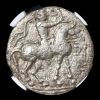|
LOT 338:
NGC Ancient Indo-Scythians, Azes I/II after c58 BC AR Tetradrachm Graded F By NGC. Indo-Scythians is the ...
more...
|
|





|
Sold for: $150
Start price:
$
20
Estimated price :
$125 - $250
Buyer's Premium: 20%
|
NGC Ancient Indo-Scythians, Azes I/II after c58 BC AR Tetradrachm Graded F By NGC. Indo-Scythians is the appellation given to the group of Scythians (Sakas) who, starting sometime around mid-2nd century BC, settled lands in south central Asia around the Indus river and along the Ratnakar coast (today called the Indian Ocean). Records of the first important Saka king, Maues, date back to early through mid 1st century BC. Maues conquered various Indo-Greek territories, gradually assimilating much of north-western modern-day India. Maues also started minting coins, typically based on the Indian square standard, and also incorporating Grecian and Buddhist elements. This coin was produced several decades later, probably under King Azes I (c. 57 BC – c. 35 BC), who founded a calendar scheme known as the Azes era. The coin is a distinctive one produced by Azes. On the obverse is the King himself, with standard and spear, a fitting representation for the ruler of former nomads. The epithet here is in Kharoshthi and roughly translates: “King of Kings Azes the Great.


